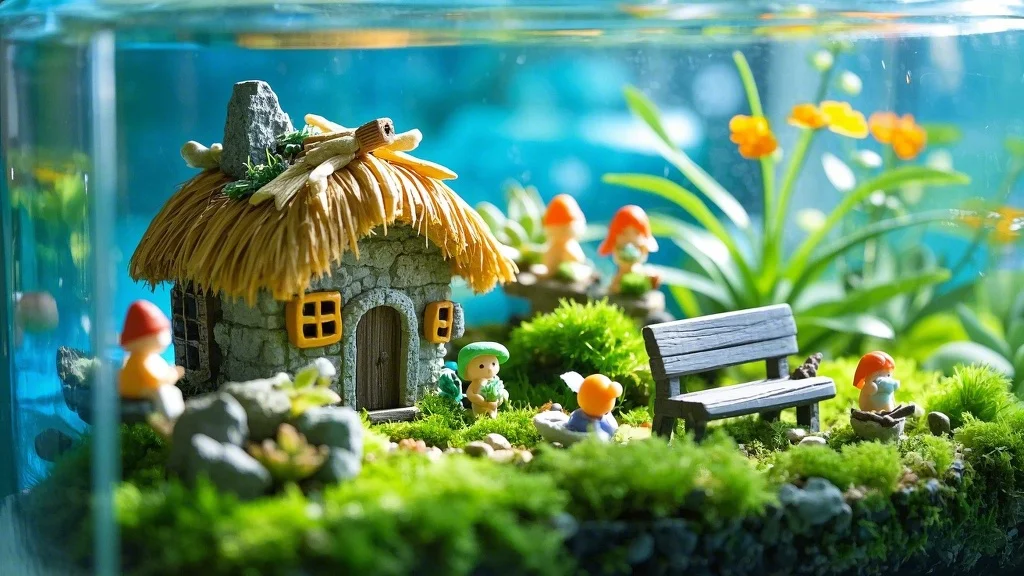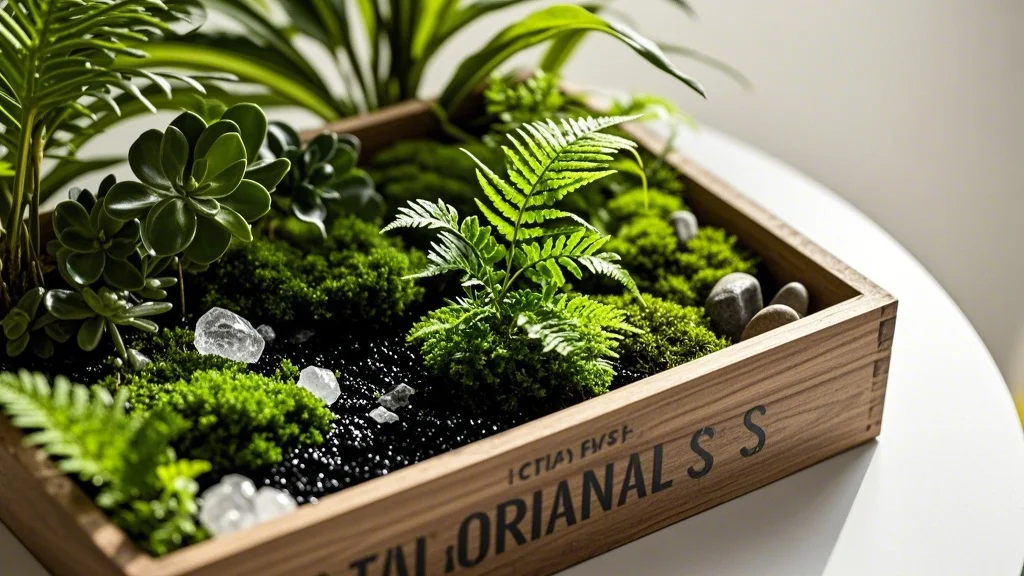Terrariums have evolved from simple plant containers to miniature works of art that capture the imagination. These self-contained ecosystems offer a canvas for creativity, allowing urban gardeners to craft enchanting miniature landscapes within the confines of glass. While healthy plants form the foundation of any terrarium, it’s the decorative elements that transform these miniature gardens into captivating scenes that tell a story.
For artistic terrarium creators and aesthetic-focused gardeners, selecting the right decorative elements can elevate a basic plant arrangement into a mesmerizing miniature world. This guide explores a curated selection of decorative elements that will enhance your terrarium’s visual appeal while complementing its natural components.
Contents
Natural Elements

Driftwood and Branches
Driftwood pieces add organic structure and visual interest to terrariums. Their weathered appearance creates a sense of age and character, perfect for establishing focal points within your miniature landscape.
Top picks:
- Spiderwood Branches: With their intricate, twisted forms, these branches create dramatic silhouettes and provide climbing surfaces for plants.
- Manzanita Driftwood: Prized for its smooth texture and rich reddish-brown color, manzanita adds warmth to cool-toned terrariums.
- Grapevine Pieces: These versatile branches can be shaped into arches or bridges, adding architectural elements to your design.
When selecting driftwood, choose pieces that have been properly cleaned and cured to prevent mold growth in your terrarium’s humid environment.
Stones and Pebbles
Stones serve both aesthetic and functional purposes in terrariums. They create visual weight, define spaces, and can improve drainage in closed systems.
Recommended varieties:
- Polished River Rocks: These smooth, rounded stones create a serene, water-worn aesthetic perfect for zen-inspired designs.
- Quartz Crystals: Clear or colored quartz points add a magical element, catching and refracting light throughout your terrarium.
- Slate Pieces: Flat slate fragments can be stacked to create miniature cliffs or used as platforms for other decorative elements.
- Lava Rock: Beyond its striking appearance, lava rock’s porous nature helps maintain humidity levels while providing additional surface area for beneficial microorganisms.
Consider arranging stones in odd-numbered groupings for a more natural, balanced composition.
Moss Varieties
While technically plants, decorative mosses deserve special mention for their ability to transform the look and feel of a terrarium.
Standout varieties:
- Reindeer Moss: Available in vibrant colors, this preserved moss adds texture and can simulate miniature shrubs or trees.
- Sheet Moss: Creates lush, carpet-like ground cover that unifies the terrarium’s floor.
- Mood Moss: Forms pillowy mounds that add dimension and a sense of ancient forest floors.
- Spanish Moss: Drapes elegantly from branches, creating a mysterious, southern gothic atmosphere.
Mix different moss varieties for textural contrast and to create more realistic miniature landscapes.
Miniature Figurines and Structures

Fairy Garden Accessories
Fairy garden elements bring whimsy and narrative to terrariums, transforming them into storybook scenes.
Popular options:
- Fairy Cottages: Tiny houses with detailed features like thatched roofs or stone facades create instant focal points.
- Miniature Furniture: Tiny benches, tables, and chairs suggest habitation and invite viewers to imagine the terrarium’s tiny residents.
- Fairy Figurines: Small fairy statues in various poses add character and a sense of magic to your creation.
- Miniature Tools: Tiny watering cans, wheelbarrows, and garden tools create charming vignettes that tell a story of care and cultivation.
When incorporating fairy elements, maintain a consistent scale throughout your design for a more cohesive look.
Architectural Elements
Architectural pieces add structure and human influence to your miniature landscape.
Standout choices:
- Miniature Bridges: These create a sense of journey and can span “rivers” made of blue glass or resin.
- Stone Archways: Frame views within your terrarium and create a sense of depth.
- Miniature Pagodas: Add an Asian-inspired aesthetic perfect for zen or Japanese garden-themed terrariums.
- Tiny Staircases: Create vertical interest and suggest pathways through your miniature world.
Consider weathering new architectural elements with a light wash of diluted brown or green paint to give them an aged, established appearance.
Themed Figurines
Themed figurines allow you to create specific narratives or aesthetics within your terrarium.
Popular themes:
- Woodland Creatures: Tiny deer, rabbits, foxes, and owls bring a forest fairytale quality to naturalistic terrariums.
- Dinosaurs: Create prehistoric scenes with miniature dinosaurs partially hidden among ferns and mosses.
- Mythological Figures: Dragons, unicorns, and other fantasy creatures transform terrariums into magical realms.
- Zen Figures: Small Buddha statues or meditation figures establish a peaceful, contemplative atmosphere.
Position figurines thoughtfully to create scenes that draw the eye and tell a story within your miniature landscape.
Decorative Substrates
Colored Sand and Gravel
Colored substrates create visual interest and can define different zones within your terrarium.
Creative applications:
- Layered Sand Art: Create striking horizontal bands of different colored sands visible through the glass sides of your terrarium.
- Pathways: Use fine white or golden sand to create winding paths through your miniature landscape.
- Colored Gravel Accents: Use small amounts of brightly colored aquarium gravel to simulate flower beds or garden borders.
- Black Sand: Creates dramatic contrast against green plants and light-colored decorative elements.
When using colored substrates, keep them separated from your planting medium to maintain plant health.
Decorative Glass
Glass elements add sparkle and color while complementing the terrarium’s container.
Beautiful options:
- Sea Glass: Tumbled glass pieces in soft blues and greens evoke water elements and coastal themes.
- Glass Gems: Flat-bottomed glass marbles create the illusion of water features or add jewel-like color accents.
- Crushed Glass: Fine crushed glass in various colors can be used to create sparkling pathways or decorative borders.
- Glass Beads: Small glass beads can simulate water droplets or be arranged in patterns for decorative effect.
Position glass elements where they’ll catch light for maximum visual impact.
Natural Accents
Small natural elements add authentic detail and texture to your terrarium landscape.
Interesting additions:
- Pinecones: Miniature pinecones create perfect scaled trees or ground decorations.
- Acorns and Seed Pods: These natural objects add organic interest and woodland character.
- Dried Flowers: Tiny dried flowers add color and delicate texture to terrarium scenes.
- Shells: Small seashells create coastal themes or can be repurposed as miniature planters or fairy bathtubs.
Ensure all natural elements are thoroughly dried and treated to prevent introducing pests or mold to your terrarium.
Lighting Elements
Fairy Lights
Battery-operated micro LED lights transform terrariums into magical nighttime displays.
Effective uses:
- String Lights: Delicate wire lights can be woven through branches or along the terrarium floor.
- Spot Lighting: Focused LED lights can highlight specific features or create dramatic shadows.
- Color-Changing Options: LEDs that cycle through different colors create dynamic, ever-changing displays.
- Remote-Controlled Systems: Allow you to adjust brightness or activate lighting effects without disturbing your terrarium.
Choose waterproof lighting options designed for terrarium use to prevent electrical issues in humid environments.
Glow-in-the-Dark Elements
Phosphorescent decorations create an enchanting nighttime display without electricity.
Magical options:
- Glow Stones: These pebbles absorb light during the day and emit a soft glow at night.
- Luminous Mushrooms: Artificial glow-in-the-dark mushrooms create a bioluminescent forest floor effect.
- Glow Paint Accents: Subtle touches of glow paint on figurines or structures create mysterious nighttime highlights.
- Phosphorescent Sand: Mixed sparingly with regular sand, creates pathways that glow after dark.
For best results, position glow elements where they’ll receive adequate light during the day to “charge” their luminescent properties.
Water Features
Simulated Water
Create the illusion of water without the maintenance challenges of actual water features.
Convincing techniques:
- Clear Epoxy Resin: When properly poured and cured, creates realistic-looking ponds, streams, or waterfalls.
- Blue Glass Pieces: Arranged in depressions, simulates the look of small pools or ponds.
- Glossy Gel Medium: Applied in thin layers, creates a wet appearance perfect for simulating small puddles.
- Mirror Fragments: Small pieces of mirror create reflective surfaces that mimic still water.
When working with resin, follow safety precautions and ensure proper ventilation during the curing process.
Misting Systems
For open terrariums, decorative misting elements add both function and visual appeal.
Stylish options:
- Copper Misting Nozzles: These can be incorporated as design elements while providing practical humidity.
- Glass Atomizers: Vintage-style spray bottles double as decorative objects when not in use.
- Automated Misting Systems: Hidden tubes and nozzles create periodic mist effects that enhance the atmosphere of your terrarium.
- Decorative Humidity Trays: Pebble-filled trays beneath terrariums increase humidity while adding to the overall aesthetic.
Position misting elements to complement rather than dominate your terrarium design.
Seasonal and Changeable Elements
Holiday Decorations
Swap out small decorative elements to celebrate seasons and holidays.
Festive ideas:
- Miniature Pumpkins: Tiny artificial pumpkins create autumn scenes.
- Snow Effects: White flocking powder or artificial snow transforms terrariums for winter displays.
- Holiday Ornaments: Scaled-down ornaments, presents, or holiday figures create seasonal cheer.
- Pastel Accents: Soft-colored decorations and egg shapes for spring and Easter themes.
Store seasonal elements in labeled containers for easy rotation throughout the year.
Interchangeable Backgrounds
Create depth and changing scenery with removable backdrop elements.
Creative approaches:
- Printed Scenery: Laminated images of skies, mountains, or forests create the illusion of distance.
- Painted Panels: Interchangeable painted backgrounds that slide behind your terrarium.
- Seasonal Imagery: Rotate backgrounds to reflect changing seasons—snowy mountains in winter, lush forests in summer.
- Gradient Backgrounds: Simple color gradients that enhance the mood of your terrarium scene.
Secure backgrounds with removable adhesive or design a slot system for easy changes.
Maintenance and Practical Considerations
Compatibility with Plant Life
When selecting decorative elements, consider their impact on your terrarium’s ecosystem.
Important factors:
- Chemical Leaching: Avoid painted or treated items that might release harmful chemicals into your terrarium environment.
- Space Requirements: Ensure decorations don’t crowd plants or prevent proper growth.
- Light Obstruction: Position taller decorative elements where they won’t block essential light from reaching your plants.
- Humidity Considerations: Some materials may deteriorate in high-humidity closed terrariums—choose accordingly.
Test new decorative elements in a small section of your terrarium before full installation.
Cleaning and Preservation
Maintain the beauty of your decorative elements with proper care.
Maintenance tips:
- Regular Dusting: Use a small, soft brush to gently remove dust from figurines and structures.
- Algae Prevention: Position decorative elements away from glass sides where algae is most likely to grow.
- Periodic Replacement: Natural elements like moss and wood may need occasional refreshing as they decompose.
- Gentle Cleaning Solutions: When necessary, use diluted plant-safe cleaning solutions for decorative elements.
Establish a regular maintenance schedule to keep your terrarium looking its best.
Conclusion
The art of terrarium decoration lies in creating balance—between natural and artificial elements, between focal points and supporting details, between creativity and restraint. The decorative elements you choose should enhance your plants rather than overshadow them, creating a harmonious miniature landscape that captivates the imagination.
Whether you prefer naturalistic woodland scenes, whimsical fairy gardens, or sleek modern designs, the right decorative elements will transform your terrarium from a simple plant container into a living work of art. Experiment with different combinations, trust your aesthetic instincts, and remember that like any garden, a terrarium is always evolving—a miniature world that grows and changes with time.
By thoughtfully selecting and arranging decorative elements, you create not just a display of plants, but a tiny landscape that tells a story—inviting viewers to peer into a world of your creation, where imagination meets nature in perfect miniature harmony.







